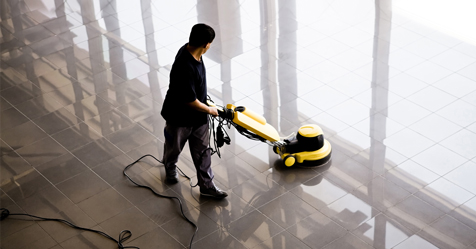Cleaning and Maintenance Management (CMM) delivered its first webcast of 2015 on the topic of hard floor care this spring. While the webcast highlighted more than an hour’s worth of emerging trends and maintenance tips, many listeners still left with questions relating to their individual floor care needs.
The CMM team wants to ensure that as many listeners as possible receive answers to their most pressing floor care questions. As a result, we have followed up with our webcast presenters for answers to many of the questions that came in from participants during the course of the program.
Below find detailed answers to three questions from webcast presenter Bill McGarvey, director of training and sustainability for Philip Rosenau Co., Inc.
We will continue to post more floor care questions and answers on our Facebook page in addition to consecutive parts to this series on our website.
I have a linoleum floor that has damage from photocopy ink. What method of cleaning can I apply?
As is often the case with floor issues, your question leads to more questions.
Do you know the brand of linoleum? What is the approximate age of the flooring? Has it been sealed and/or finished since installation? If so, with what products? All of the answers to these questions can have a bearing on how best to proceed.
You might try—however, PLEASE test in an inconspicuous area first—to apply a small amount of mineral spirits to a cloth and rub the affected area. Be sure to wear appropriate personal protective equipment and be aware that you are working with a flammable product.
If the treatment is working, you should see a color transfer onto the cloth. If it does, continue working in small sections, rubbing gently. Also, remember to be patient. Too often we look for a quick fix and switch to more aggressive methods, which can cause irreversible damage. If the floor is the Marmoleum brand from Forbo, they have a soy-based adhesive remover that may be worth trying, as well.
Do you have any tips for cleaning LEED-certified flooring?
LEED-certified is a broad category. However, here are five tips for cleaning LEED-certified flooring:
- Refer to the manufacturer’s instructions for cleaning your floor.
- Consult with your supplier. If they can’t help you, it may be time to look for a new supplier.
- Beyond that, a Green Seal Certified neutral floor cleaner combined with an automatic scrubber or a microfiber flat-mop system should be fine for daily maintenance. Other technologies available include ionized/electrolyzed water, either incorporated within the equipment or dispensed independently.
- For periodic or restorative measures, consider trying slightly more aggressive floor pads, but don’t jump right to extremes. Work your way up the ladder and test them in out-of-the-way places first.
- No conversation about floor care would be complete without a reminder to invest in adequate matting.
If polyurethane is applied to a laminate floor, what is the best way to remove it?
Unfortunately, there may not be a good way to deal with this. Different laminate products have different compositions. While many do have a wood or wood-veneer surface, some are nothing more than a picture of wood grain glued to the substrate.
As always, if possible, consult with the manufacturer or installers on how to best tackle this issue. If that does not produce results you can use, you might consider screening the floor. This will not completely remove the coating, but instead, it will abrade the coating so that a new coating can hold on to it.
I would recommend using No. 120 or No. 150 grit screens to reduce visible scratches. I would also recommend using an approved cleaner, so you can complete this process on a wet surface rather than on a dry one. Do not oversaturate the floor, but keep it wet enough to control the dust produced by screening. You could then apply a coat or two of an appropriate coating.
If this is something you have not done before, contact your supplier for guidance.
Also, if there is damage to the floor, such as peeling or stains, this process will not remove/repair it. Rather, it might be time to contact a flooring installer to see if the floor has enough material to sand it down. Most laminates that can be sanded only have enough material for sanding one or two times before replacement may be necessary.


